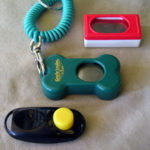CPT Provides Clicker Training Seminar to Staff

May 13, 2013
CPT Provides Clicker Training Seminar to Staff
On Monday, May 13, 2013 CPT presented a clicker training seminar to its trainers and support staff. The seminar began with a discussion regarding the role of the clicker, which in the belief of CPT is most advantageous when:
- Conducting imprint training with puppies, when
- Working with anxious, but noise tolerant dogs, who are nervous amidst humans or when hearing the human voice,
- Conducting counterconditioning drills with a majority of human or dog aggressive animals,
- Conducting shaping drills for complex exercises, and
- Working with owners/handlers who are not adept at vocal modulation and/or human-dog verbal communication.
The benefits of the clicker in such cases are due to greater clarity in communication versus using the human voice as the primary secondary reinforcer or reward marker; superior timing and accuracy as a reward marker versus using the human voice, which is especially advantageous when conducting complex shaping exercises; superior attention and motivation on the part of the animal, which is most salient when working with puppies; and increased confidence and security by the animal, especially if the animal has experienced harsh verbal reprimands or the owner lacks vocal modulation skills.
Similarly, we concluded that the clicker may be contraindicated when:
- A subject dog is noise averse,
- A dog becomes inordinately sensitized or aggressive when hearing the clicker,
- A handler lacks the physical coordination, mental coordination, or confidence to include the clicker in his/her dog’s training, and
- A client states a strong preference to continue training without the clicker.
The seminar then progressed to a discussion of terms pertinent to an understanding of applied behavioral psychology, especially instrumental conditioning and operant conditioning. Terms discussed included:
- Thorndike’s Law of Effect: Stamped-in vs. Stamped-out,
- Operants,
- Consequences,
- Positive reinforcement,
- Shaping,
- Chaining,
- Positive punishment vs. negative punishment vs. negative reinforcement,
- Extinction
- Prompting and Cueing,
- Fading,
- Discrimination,
- Contextual learning,
- Sequential learning,
- Generalization,
- Contingency,
- Consistency,
- Reinforcement schedules (constant, fixed, variable, random, diminishing frequency, attached to performance standards),
- Immediacy/timing,
- Satiation,
- Deprivation, and
- Size/magnitude/value
The seminar then proceeded to instruct trainers how the above behavioral principles were applied in the Emory-CPT fMRI project. Mark Spivak discussed how the processes and concepts of assessment, identification of pertinent behaviors and variables, shaping, desensitization, discrimination, magnitude, consistency, and immediacy were employed when training the subject dogs for the team’s groundbreaking research. Mark also discussed some of the findings and how they relate to the training of pet dogs. Mark emphasized how Experiment 1 of the study concluded that the dogs’ nucleus acumbens, a brain center within the caudate that via dopamine release indicates anticipatory reward behavior, showed activation only upon receiving a hand signal that communicated an imminent reward. The preceding findings illustrated how the dogs’ brains reacted to training that properly incorporated classical and operant conditioning principles.
The seminar then further progressed from the theoretical to the practical when CPT Trainer Lisa Carrol, who also trains and competes with horses, described how she used the clicker to implement behavior shaping with a horse. Lisa described the sequential clicker-based process to teach one of her horses to pick up a hat and carry it to her. Lisa then discussed what she observed are the advantages of clicker training in comparison to “traditional” horse training methods. She believes clicker training produces superior attitudes, confidence, and outcomes and is more enjoyable for both the handler and the horse than is traditional training.
CPT Trainer Karen Smalley then brought out her Border Collie, Bodhi. Karen and Bodhi demonstrated “free shaping” and several tricks taught with the clicker. Bodhi obviously enjoyed the clicker-based training and remained eager to work, regardless of whether he was asked to perform an old behavior or to learn the rudiments of a complex new behavior.
The seminar then concluded with an open roundtable discussion. CPT periodically sponsors seminar-based training for its staff, so that the staff continues to grow and expand to remain the most educated and experienced training staff in Atlanta.
For more information about CPT or about the Emory-CPT Neuroscience Project, please contact Mark Spivak by email (MarkCPT@aol.com) or by phone (404-236-2150).


